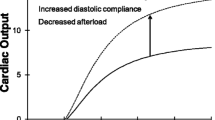Abstract
The purpose of this investigation was to develop a theoretical framework to predict stroke volume (and therefore cardiac output) when the ventricle is coupled with the arterial impedance. The ultimate objective is to arrive at an analytical description of cardiac output in the closed hydraulic loop of the entire circulatory system on the basis of the properties of the major system components. We developed the framework of analysis of ventriculo-arterial coupling by characterizing both the ventricle and arterial system in terms of the end-systolic pressure vs. stroke volume (Pes-SV) relationships. This approach, motivated by the load-insensitivity of ventricular end-systolic pressure-volume relationship (ESPVR), yielded stroke volume as the intersection between the ventricular Pes-SV relationship and arterial Pes-SV relationship. The theoretical outcome was validated by comparing the stroke volume predicted as a result of interaction between a given ventricular ESPVR and a set of arterial impedances against those SVs actually measured by imposing the same arterial impedance on the isolated canine ventricles. Furthermore, because of the mathematical simplicity of this approach, it enabled us to describe cardiac output in the closed circulatory loop with a small set of analytical equations. We conclude that the proposed framework is useful in analyzing the ventriculo-arterial coupling and various mechanisms which affect cardiac output in the closed circulatory loop.
Similar content being viewed by others
References
Attinger, E.O., A. Anné, and D.A. McDonald. Use of Fourier series for the analysis of biological systems.Biophys. J. 6:291–304, 1966.
Brunner, M.I., A.S. Greene, K. Sagawa, and A.A. Shoukas. Determinants of systemic zero-flow arterial pressure.Am. J. Physiol. 245 (Heart Circ. Physiol. 14):H453-H460, 1983.
Dick, D.E., J.E. Kendreick, G.L. Matson, and V. C. Rideout. Measurement of nonlinearity in the arterial system of the dog by a new method.Circ. Res. 22: 101–112, 1968.
Elzinga, G. and N. Westerhof. Pressures and flow generated by the left ventricle against different impedance.Circ. Res. 32:178–186, 1973.
Elzinga, G., H. Piene, and J.P. Jong. Left and right ventricular pump function and consequences of having two pumps in one heart. A study on the isolated cat heart.Circ. Res. 46:564–574, 1980.
Guyton, A.C. Venous return. InHandbook of Physiology, Section 2, Vol. 2: Circulation, ed. by W.F. Hamilton. Washington, D.C.: American Physiological Society, 1963, pp. 1099–1133.
Guyton, A.C., C.E. Jones, and T.G. Coleman.Circulatory physiology: Cardiac output and its regulation. Philadelphia: Saunders, 1973, pp. 1–556.
Herndon, C.W. and K. Sagawa. Combined effects of aortic and right atrial pressures on aortic flow.Am. J. Physiol. 201: 102–108, 1969.
Nichols, W.W., C.R. Conti, W.E. Walker, and W.R. Milnor. Input impedance of the systemic circulation in man.Circ. Res. 40:451–458, 1977.
Milnor, W.R.Hemodynamics. Baltimore: Williams & Wilkins, 1982, pp. 157–191.
Noble, M.I.M., I.T. Gabe, D. Trenchard, and A. Guz. Blood pressure and flow in the ascending aorta of conscious dog.Cardiovasc. Res. 1:9–29, 1967.
Piene, H. and T. Sund. Flow and power output of right ventricle facing load with variable input impedance.Am. J. Physiol. 237 (Heart Circ. Physiol. 6):H125-H130, 1979.
Piene, H. Interaction between the right heart ventricle and its arterial load: A quantitative solution.Am. J. Physiol. 238 (Heart Circ. Physiol. 7):H932-H937, 1980.
Piene, H. and T. Sund. Calculation of flow and pressure curves from the ventricular pressurevolume-time relationship and load impedance. InCardiovascular System Dynamics: Models and Measurements, edited by T. Kerrer, R. Busse, and H. Hinghofer-Salkay, New York and London: Plenum Press, 1982, pp. 47–56.
Piene, H. and T. Sund. Does normal pulmonary impedance constitute the optimum load for the right ventricle?Am. J. Physiol. 242 (Heart and Circ. Physiol. 11):H154-H160, 1982.
Sagawa, K. Analysis of the ventricular pumping capacity as a function of input and output pressure loads. InPhysical Basis on Circulatory Transport: Regulation and Exchange, edited by E.B. Reeve and A.C. Guyton Philadelphia: Saunders, 1967, pp. 143–151.
Sagawa, K. and A. Eisner. Static pressure-flow relation in the total systemic vascular bed of the dog and its modification by the baroreceptor reflex.Circ. Res. 36:406–413, 1975.
Sagawa, K. The end-systolic pressure-volume relation of the ventricle: Definition, modifications and clinical use.Circulation 63:1223–1227, 1981.
Shoukas, A. Carotid sinus baroreceptor reflex control and epinephrine: Influence on capacitive and resistive properties of the total pulmonary vascular bed of the dog.Circ. Res. 51:95–101, 1982.
Suga, H., K. Sagawa, and A.A. Shoukas. Load independence of the instantaneous pressure volume ratio of the canine left ventricle and effects of epinephrine and heart rate on the ratio.Circ. Res. 32:314–332, 1973.
Suga, H. and K. Sagawa. Instantaneous pressure-volume relationshhips and their ratio in the excised, supported canine left ventricle.Circ. Res. 35:117–125, 1974.
Suga, H. End-systolic pressure-volume relations. Letter to the editor.Circulation 59:419–420, 1979.
Suga, H., A. Kitabatake, and K. Sagawa. End-systolic pressure determines stroke volume from fixed end-diastolic volume in the isolated canine left ventricle under a constant contractile state.Circ. Res. 44:238–249, 1979.
Sunagawa, K., D. Burkhoff, K. Lim, and K. Sagawa. Impedance loading servo pump system for excised canine ventricle.Am. J. Physiol. 243 (Heart Circ. Physiol. 12):H346-H350, 1982.
Sunagawa, K., W.L. Maughan, and K. Sagawa. Influence of heart rate on the sensitivity of stroke volume to afterload compliance and resistance.Circulation 66:II-304, 1982.
Sunagawa, K., W.L. Maughan, D. Burkhoff, and K. Sagawa. Left ventricular interaction with arterial load studied in isolated canine ventricle.Am. J. Physiol. (Heart and Circ. Physiol.) In press.
Westerhof, N., G. Elzinga, and P. Sipkema. Artificial arterial system for pumping hearts.J. Appl. Physiol. 31:776–781, 1971.
Author information
Authors and Affiliations
Rights and permissions
About this article
Cite this article
Sunagawa, K., Sagawa, K. & Maughan, W.L. Ventricular interaction with the loading system. Ann Biomed Eng 12, 163–189 (1984). https://doi.org/10.1007/BF02584229
Issue Date:
DOI: https://doi.org/10.1007/BF02584229




